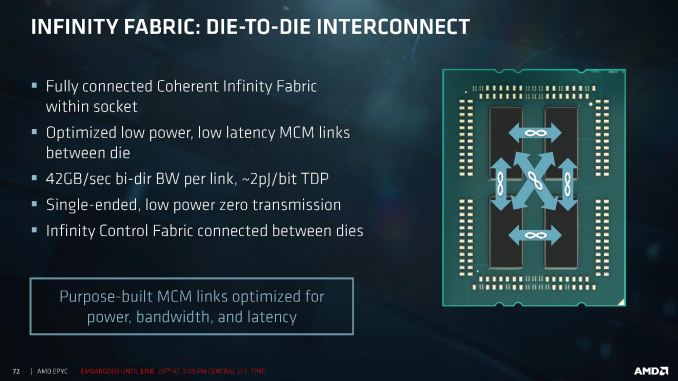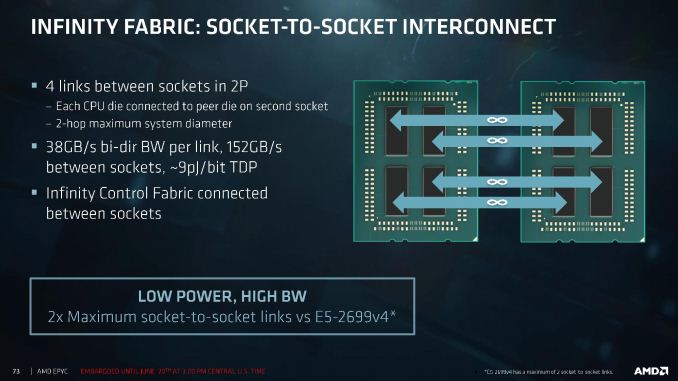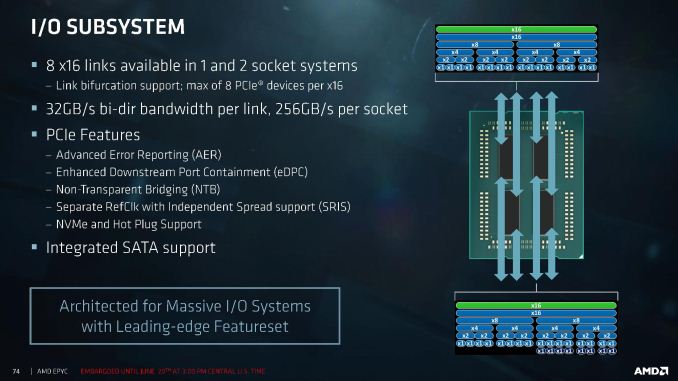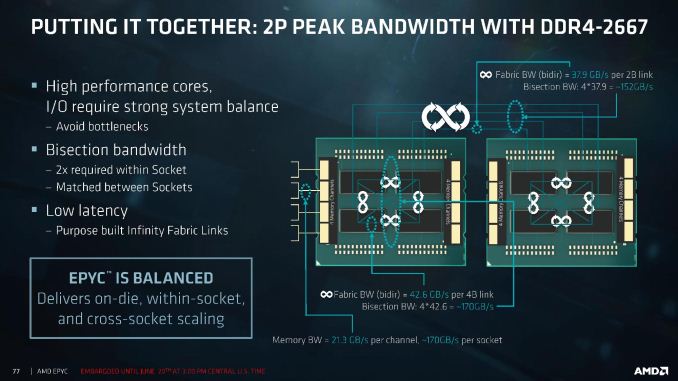AMD's Future in Servers: New 7000-Series CPUs Launched and EPYC Analysis
by Ian Cutress on June 20, 2017 4:00 PM EST- Posted in
- CPUs
- AMD
- Enterprise CPUs
- EPYC
- Whitehaven
- 1P
- 2P
NUMA NUMA IEI: Infinity Fabric Bandwidths
The news about AMD using four Zeppelin dies from Ryzen to form EPYC is not new news, having been shown several times before. However, given the design of the silicon and how the cores communicate, there has been a few worries about how the intra-package communications will be affected by not being a single monolithic die. Beyond that, socket-to-socket communications can also be an issue without sufficient latency and bandwidth.
In a single monolithic die, the latency to access other cores is usually a predictable average, with a regular latency and bandwidth out to the memory channels. Because EPYC has two memory channels per die, if a core needs to access DRAM associated with another die, it adds additional hops and latency to the access, slowing down potential instruction throughput. In the land of dual socket systems, this is known as NUMA: Non-Unified Memory Architecture. The way around a NUMA environment is data locality – keeping the data that a core needs as close as feasibly possible. Solving NUMA is a difficult task, and attempted both at the silicon and software level. Most high-end professional software packages designed for dual-socket systems are NUMA aware, and are designed to compensate for this. The majority of non-high-end software though, is not.
Intra-Socket
With the quad-die design, a single EPYC processor might essentially have four zones for NUMA to occur, based on communication paths. AMD went to specifically address this issue in their design briefings.
Within a single processor, each of the three dies is directly linked to each other through the Infinity Fabric, so only one hop is ever needed when data goes off-die. The connectivity here is set at a bidirectional 42.6 GB/sec per link, at around an average energy of ~2 pJ per bit (or 0.672W per link, 0.336W per die per link, totaling 4.032W for the chip). It is worth noting that Intel’s eDRAM for Broadwell was set as a 50 GB/s bidirectional link, so in essence moving off die in EPYC has a slightly slower bandwidth than Crystalwell. With a total of six links within the silicon, that provides a total of 2 terabits per second of data movement, although AMD didn’t state what the bottlenecks or latency values were.
Inter-Socket
Socket-to-socket communication is designed at the die level, rather than going through a singular interface. One die in each processor is linked to the same die in the other processor, meaning that for the worst-case scenario data has to make two hops to reach a core or memory controller on the other side of the system. Each link has a bidirectional 37.9 GB/s bandwidth, which is only slightly less than the intra-socket communication bandwidth, although we would expect socket-to-socket to have a slightly higher latency based on distance. AMD has not shared latency numbers at this time.
At 37.9 GB/s per link, this totals 152 GB/s between sockets, which AMD states runs at an average of 9 pJ per bit. So at full speed, this link will consume 10.94W between the two sockets, or 5.48W per processor and 1.368W per silicon die.
Totaling the 1.368W per die for socket-to-socket plus 3*0.336W per die for intra-socket communications, the Infinity Fabric can consume 2.376W per silicon die on average when going at full speed.
Infinity Fabric Latency
AMD has not provided Infinity Fabric numbers for latency. We are waiting on information, but this is likely going to be a critical answer for some software packages. Based on testing done by PC Perspective, we already know some latency numbers within a single Zeppelin die from the Ryzen platform. This allows us to fill in the following table showing how long it takes to ping another core:
| EPYC (Naples) Thread Ping Connections | ||
| Latency | Bandwidth | |
| Within A Core | 26 ns | - |
| Core-to-Core, Same CCX | 42 ns | - |
| Core-to-Core, Different CCX, Same Die | 142 ns | - |
| Die-to-Die, Same Package | ? | 42.6 GB/s |
| Die-to-Die, Different Socket, One Hop | ? | 37.9 GB/s |
| Die-to-Die, Different Socket, Two Hops | ? | 37.9 GB/s |
| Core to DRAM, Same Die | ? | 42.6 GB/s |
| Core to DRAM, Different Die | ? | 42.6 GB/s |
| Core to DRAM, Different Socket, One Hop | ? | 37.9 GB/s |
| Core to DRAM, Different Socket, Two Hops | ? | 37.9 GB/s |
PCIe Bandwidth
Each Zeppelin die can create two PCIe 3.0 x16 links, which means a full EPYC processor is capable of eight x16 links totaling the 128 PCIe lanes presented earlier. AMD has designed these links such that they can support both PCIe at 8 GT/s and Infinity Fabric at 10.6 GT/s, although in PCIe mode this means 32GB/s of bidirectional bandwidth per link, suitable for 256GB/s per socket. One of AMD’s proposed benefits here is link bifurcation support:
Each x16 link can support Infinity Fabric (green), PCIe (blue) and SATA (dark blue). PCIe can be bifurcated all the way down to sets of x1, although there will be a limit of 8 PCIe devices per x16 link, but this becomes a mix and match game: x8 + x4 + x2 + x1 + x1 + x1 + x1 becomes entirely valid for a single x16 link, and each CPU has eight of these such links. For the SATA connectivity, each x16 link can support 8 SATA drives as a result. If you really want 64 devices per processor, welcome to your platform without buying PCIe switches. AMD states that as an NVMe implementation, supporting 32 NVMe devices is going to be no sweat for an EPYC system.
This also relates to the Sever Controller Hub, which acts as part of the design offering four USB 3.0 ports, SMBus, I2C, SPI, eSPI, TPM, GPIOs, timers and UARTs.
Combining The Bandwidth
Altogether, AMD is stating that they are relatively unconcerned about NUMA related issues, with bandwidth between dies and between sockets being relatively similar. It is worth noting that the 42.6 GB/s die-to-die bandwidth is identical to the dual-channel memory bandwidth quoted per die:
Time will tell if these become bottlenecks. Latency numbers please, I’d love to fill in that table above.















131 Comments
View All Comments
vladx - Tuesday, June 20, 2017 - link
Lol what a shady move from AMD to reduce Intel CPUs' benchmark numbers in order to make Epyc appear better than it actually is, never change AMD never change.tamalero - Tuesday, June 20, 2017 - link
COUGH COUGH COUGH Yeah, because Intel never has done the same.. COUGH COUGH COUGH..https://www.extremetech.com/computing/193480-intel...
https://www.theinquirer.net/inquirer/news/1567108/...
vladx - Tuesday, June 20, 2017 - link
First there's a big difference between straight-out misleading customers and making backside deals with OEMs, and second that compiler crippling stuff is still unsubstantiated and Intel has no obligation towards AMD with regards to Intel's own compiler. AMD should make their own compiler that offers better or at least equal to Intel's own optimizations instead of using disgraceful tactics like that.galahad05 - Wednesday, June 21, 2017 - link
How's Intel doing fighting that enormous fine the EU levied against it for their underhanded tactics against AMD years ago?vladx - Wednesday, June 21, 2017 - link
Afaik they paid billions which AMD squandered like it was nothing.galahad05 - Wednesday, June 21, 2017 - link
Um.... Where to begin?The fine doesn't go to AMD. It goes to the European Commission....
So far Intel's lawyers have held the EC at bay all these years. Which technically means Intel got away with it....
Such is life.
Mugur - Wednesday, June 21, 2017 - link
What I don't understand from the slide with the prices: it looks like the 1P cpu is priced higher ($750 versus $650) than the 2P counterpart? I assume that any 2P cpu could be used in a 1P motherboard, but not the other way around.Zizy - Wednesday, June 21, 2017 - link
Well, the corresponding 2P part is >1.1k, so 1P is cheaper. No idea why there isn't 7301P instead and slightly cheaper than the bottom 2P, but I guess that 7351P looks better on the 2P vs 1P.1008anan - Wednesday, June 21, 2017 - link
Trying to calculate how many 32 bit floating point operations (FPO) a zen server completes per second:Assume a 2 socket Zen server with two 32 core chips; operating at 2.5 gigahertz:
512 bits wide vector, Fused Multiply Add, two FPO per clock = 64 FPO per clock = 512/32 * 2 * 2.
64 FPO/clock * 32 cores = 2048 FPO/clock
2048 FPO/clock * 2 sockets = 4096 FPO/clock
4096 FPO/clock * 2.5 gigahertz = 10 trillion FPO/second = 10 teraflops
Is this accurate? Is Zen approximately the same number of FLOPS as Skylake E5/E7?
edzieba - Wednesday, June 21, 2017 - link
An interesting diagram lurking on the corner of this slide: http://images.anandtech.com/doci/11551/epyc_tech_d...Could just be that the diagram is nonsense marketing bling, but that sure looks like external lanes are connected to only two of the 4 cores, with the remaining two getting 'passthrough' lanes.